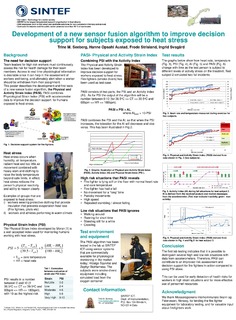| dc.description.abstract | Team leaders for high risk workers must continuously assess the risk for health damage for their team members. Access to real time physiological information is desirable since it can help in the assessment of workers well-being, and ultimately alert when a worker should be withdrawn from their assignment. Heat stress occurs when humidity, air temperature, radiant heat and too little air movement, combined with heavy work and clothing, raise the body temperature beyond safe limits. In effect, heat stress reduces the person’s physical reactivity and ability to reason clearly. A new sensor fusion algorithm, the Physical and Activity Strain Index (PASI) has been developed to improve decision support for workers exposed to heat stress. Fire-fighters (smoke divers) has been used as test case. PASI combines the Physiological Strain Index (PSI) with accelerometer data.The Physical Strain Index developed by Moran [1] is a well accepted index used for monitoring humans working with heat stress. The input parameters are heart rate and core temperature.PASI consists of two parts, the PSI and an Activity Index (AI). As for PSI the output of the algorithm will be a number between 0-10 (for 36.5oC <= CT <= 39.5oC and 60bpm <= HR <= 180bpm). PASI = PSI + AI, where AIMAX = 10-PSI. PASI combines the PSI and the AI, so that when the PSI increases, the toleration for the AI will decrease and vice versa. The first lab testing indicates that it is possible to distinguish several high and low risk situations with data from accelerometers. Therefore, PASI can contribute to an improved risk assessment and decision support for fire fighters in action compared to using PSI alone. This can be used for early detection of health risks for workers in high strain situations and for more effective use of personnel resources. | |
